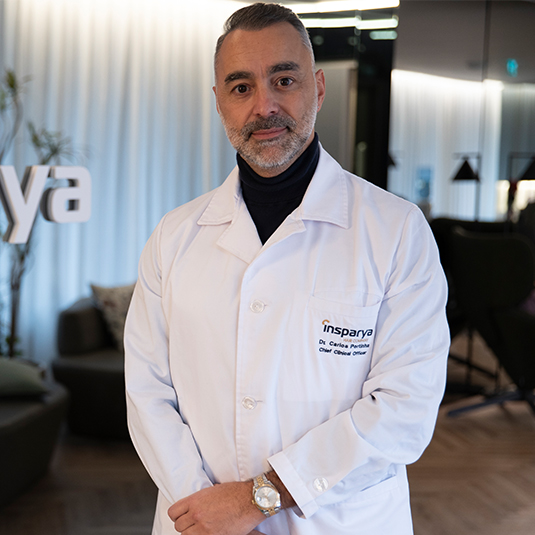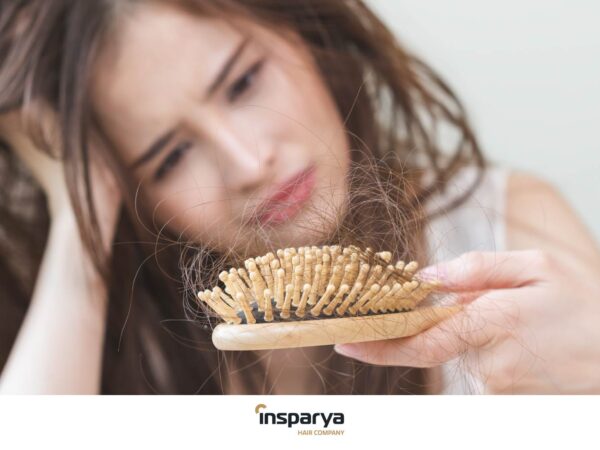
Alopecia androgénica: causas, síntomas y tratamientos
- ¿Qué es la alopecia androgénica?
- Causas de la alopecia androgénica
- Síntomas y progresión de la alopecia androgénica
- Primeros signos y cómo identificarlos
- Patrones de pérdida de cabello en hombres y mujeres
- Etapas de la alopecia androgénica
- Diagnóstico de la alopecia androgénica
- Tratamientos disponibles para la alopecia androgénica
- ¿Se puede detener la alopecia androgénica?
- Alopecia androgénica en mujeres
- Impacto psicológico y emocional de la alopecia androgénica
- Prevención y cuidados del cabello
- Avances y perspectivas futuras en el tratamiento de la alopecia androgénica
¿Qué es la alopecia androgénica?
La alopecia androgénica o androgenética es la forma más común de caída capilar en los hombres, afectando al 80 % de ellos a lo largo de su vida. En las mujeres, aunque menos frecuente, afecta aproximadamente al 20 %. A medida que los hombres alcanzan los 50 años, alrededor del 50 % ya padece este tipo de alopecia, mientras que en las mujeres su incidencia aumenta al 40 % a partir de los 70 años. Sin lugar a dudas, la alopecia androgénica es uno de los tipos de alopecia más habituales.
Características principales
Como decíamos, la alopecia androgénica es el tipo más común de pérdida de cabello, causada principalmente por factores genéticos y hormonales. Se caracteriza por:
- Progresión gradual: la pérdida de cabello avanza de manera lenta pero constante, afectando a áreas específicas del cuero cabelludo.
- Sensibilidad a la DHT: es causada por la sensibilidad de las unidades foliculares a la dihidrotestosterona (DHT), un derivado de la testosterona que provoca la miniaturización del cabello y acorta su ciclo de vida.
- Patrón definido: en los hombres, suele comenzar con el retroceso de la línea frontal y una disminución de densidad en la coronilla. En las mujeres, se manifiesta como un adelgazamiento difuso en la parte superior y central del cuero cabelludo.
- Es permanente: sin tratamiento, la pérdida capilar puede ser irreversible, ya que las unidades foliculares afectadas dejan de producir cabello.
La alopecia androgénica no afecta la salud general, pero sí puede tener un impacto emocional significativo, porque puede llegar a influir negativamente en la calidad de vida al comprometer la confianza personal. Por esta razón, en Insparya, con más de 70.000 trasplantes realizados con éxito, sabemos que un trasplante capilar no solo restaura el cabello, sino que también puede mejorar la autoestima y contribuir al bienestar emocional.
Hay que tener en cuenta que los pacientes que sufren alopecia tienen también su cuero cabelludo más expuesto a los efectos dañinos de los rayos UV. Por tanto, pueden tener más posibilidades de contraer cáncer de piel, que es uno de los cánceres que más mata en toda España y que tiene, en buena parte de los casos, un punto de partida en el cuero cabelludo. Así, al regenerar el pelo con tratamientos o restaurar áreas calvas de los pacientes con trasplante, les devolvemos la protección natural permanente en el cuero cabelludo contra esta enfermedad.
Diferencias entre hombres y mujeres
La alopecia androgénica masculina y femenina comparten una causa común: la sensibilidad genética a la dihidrotestosterona (DHT). Sin embargo, se manifiestan de manera diferente en cada sexo.
En los hombres, la alopecia androgénica suele presentarse con un patrón bien definido, caracterizado por el retroceso de la línea del cabello en la frente y las sienes (entradas), además de una pérdida progresiva en la coronilla. En algunos casos, puede llevar a la calvicie total en determinadas áreas.
En las mujeres, esta condición se manifiesta como un adelgazamiento difuso del cabello, especialmente en la parte superior y central del cuero cabelludo, mientras que la línea frontal generalmente permanece intacta. Estas diferencias en los patrones de caída se deben a factores hormonales y genéticos específicos de cada sexo.
Causas de la alopecia androgénica
La alopecia androgénica puede manifestarse en edades tempranas, como a los 20 años, pero cuando más se hace notoria es a partir de los 50 años. Las causas se pueden resumir en dos, principalmente:
Factores genéticos y hormonales
La alopecia androgénica es causada por una combinación de factores genéticos y hormonales que determinan la sensibilidad de las unidades foliculares a la dihidrotestosterona (DHT). En personas predispuestas, la DHT se une a los receptores de las unidades foliculares, lo que provoca su miniaturización progresiva. Este proceso acorta la fase de crecimiento del cabello (fase anágena) y prolonga la fase de reposo (fase telógena). ¿El resultado? Un cabello cada vez más fino, que eventualmente puede conducir a la pérdida total y definitiva de la unidad folicular afectada.
La predisposición genética puede heredarse tanto de la línea materna como de la paterna, aunque esta última suele tener un mayor impacto, y su intensidad varía según la persona. Además, los niveles hormonales desempeñan un papel crucial; por ejemplo, un exceso de DHT o un desequilibrio hormonal puede acelerar el proceso, especialmente durante etapas sensibles como la pubertad o la menopausia.
Otros factores que influyen en su desarrollo
Aunque la genética y las hormonas son los principales desencadenantes, hay otros factores pueden acelerar o agravar la alopecia androgénica:
- Estrés: el estrés crónico puede alterar los ciclos de crecimiento del cabello, provocando una caída más rápida en personas que ya tienen predisposición.
- Nutrición: deficiencias en nutrientes esenciales como hierro, zinc, biotina (vitamina B7) o proteínas pueden debilitar el cabello y agravar la pérdida capilar.
- Hábitos de vida: fumar, consumir demasiado alcohol o tener una higiene capilar poco adecuada también pueden impactar negativamente en la salud del cuero cabelludo y, por tanto, del cabello.
- Enfermedades o medicamentos: trastornos como el hipotiroidismo, el síndrome de ovario poliquístico (SOP) o el uso prolongado de ciertos medicamentos (como antidepresivos o esteroides) pueden potenciar la caída del cabello.
- Factores ambientales: la contaminación, el daño solar o el uso excesivo de productos químicos o herramientas de calor pueden debilitar el cabello y acelerar la alopecia.
Estos factores no causan la alopecia androgénica por sí solos, pero pueden ser determinantes en la rapidez de su progreso y en cómo de notoria se hace la pérdida capilar. Por tanto, adoptar hábitos saludables y apostar por un cuidado adecuado del cuero cabelludo, con productos de calidad y una higiene adecuada es fundamental para mitigar sus efectos.
Síntomas y progresión de la alopecia androgénica
Primeros signos y cómo identificarlos
Los primeros signos de la alopecia androgénica suelen ser sutiles, por lo que es fácil que pasen desapercibidos. En los hombres, comienza con un retroceso de la línea del cabello en la frente y las sienes, de forma muy gradual. Es lo que se conoce como entradas. Sin embargo, en las mujeres el patrón es distinto: se manifiesta como un adelgazamiento generalizado del cabello, sobre todo en la zona central y superior de la cabeza.
Otros síntomas son:
- Mayor cantidad de cabello en el cepillo o la ducha.
- Reducción en el volumen y densidad del cabello.
- Aparición de «cabellos miniaturizados», es decir, más finos y débiles que los normales.
Reconocer estos signos es esencial para iniciar un tratamiento a tiempo. Solo de esta forma se puede frenar el avance de la caída capilar con un tratamiento personalizado como los que ofrece el equipo de especialistas de Insparya.
Patrones de pérdida de cabello en hombres y mujeres
La alopecia androgénica se presenta con patrones distintos según el sexo del paciente. Estos patrones reflejan una sensibilidad distinta de las unidades foliculares a la DHT, así como las influencias hormonales específicas.
- En hombres se produce un retroceso de la línea del cabello en forma de «M». Además, una pérdida progresiva en la coronilla, que puede llegar a unirse con las áreas frontales. En casos avanzados, queda una franja de cabello en los laterales y la parte posterior.
- En mujeres, es un adelgazamiento difuso en la parte superior del cuero cabelludo, especialmente en la línea central (según el patrón de Ludwig). Se nota una pérdida de densidad, pero sin un retroceso claro de la línea frontal. Hay que tener en cuenta que la alopecia total es bastante menos frecuente en comparación con los hombres.
Etapas de la alopecia androgénica
La progresión de la alopecia androgénica puede clasificarse en etapas según su gravedad y el sexo del paciente:
En hombres se utiliza la escala de Norwood-Hamilton, que define siete etapas:
- Pérdida mínima de cabello.
- Retroceso leve de la línea frontal y temporal.
- Pérdida más evidente en las entradas y coronilla.
- Las áreas de pérdida en la coronilla y la línea frontal comienzan a unirse.
- 5-7. Avance hacia una calvicie más extensa, dejando solo una franja de cabello en los laterales y la nuca.
En mujeres se aplica la escala de Ludwig, que clasifica tres etapas:
1. Adelgazamiento ligero y difuso en la línea central.
2. Mayor pérdida en la zona superior, con una línea más ancha de cuero cabelludo visible.
3. Adelgazamiento avanzado, con una pérdida de densidad notable en la parte superior, pero sin calvicie completa.
Entender estas etapas permite una evaluación precisa y la implementación de tratamientos adaptados al grado de pérdida capilar y al caso individual.
Diagnóstico de la alopecia androgénica
El diagnóstico temprano de la alopecia androgénica es clave para implementar un tratamiento eficaz y ralentizar su progresión. Esto implica una evaluación detallada que incluye la observación clínica y tricoscópica, pruebas específicas y, en ocasiones, estudios adicionales para descartar otras causas de pérdida capilar.
Exámenes y pruebas para confirmar el diagnóstico
El diagnóstico de la alopecia androgénica comienza con una consulta médica, donde se evalúan el historial familiar, los síntomas y los patrones de pérdida capilar. Esta primera sesión es determinante para definir qué exámenes y pruebas son las más indicadas para confirmar si se padece o no alopecia. Así, el médico especialista en salud capilar realizará estas pruebas:
- Examen físico del cuero cabelludo: observación de los patrones de pérdida de cabello (retroceso de la línea frontal, adelgazamiento difuso, etc.).
- Identificación de signos como miniaturización del cabello o zonas de más pérdida de densidad.
- Prueba de tracción: consiste en tirar suavemente del cabello para observar la cantidad que se desprende, algo que puede indicar una fase telógena demasiado acusada.
- Dermatoscopia o tricoscopia: con un dermatoscopio se analizan al detalle el estado del cuero cabelludo y de las unidades foliculares. Así se consigue identificar si hay miniaturización, disminución de densidad y también posibles alteraciones dermatológicas.
- Análisis de sangre: para descartar enfermedades subyacentes como anemia, deficiencia de hierro, disfunción tiroidea o desequilibrios hormonales que puedan contribuir a la caída del cabello.
- Biopsia del cuero cabelludo: se extrae una pequeña muestra de piel para analizarla bajo el microscopio. Es útil para confirmar la miniaturización folicular típica de la alopecia androgénica y diferenciarla de otros tipos de alopecia.
Cuándo consultar a un profesional
Es importante consultar a un dermatólogo o especialista en tricología si se presentan los siguientes signos:
- Pérdida progresiva de cabello: adelgazamiento evidente o retroceso de la línea frontal a lo largo de varios meses.
- Cambios en la calidad del cabello: miniaturización o cabello más fino y quebradizo.
- Historial familiar de alopecia: si hay antecedentes familiares de alopecia androgénica, el riesgo de padecerla es mayor.
- Caída excesiva y repentina: puede indicar una condición subyacente que requiera tratamiento inmediato.
- Consecuencias emocionales: si la pérdida de cabello está afectando la autoestima o causando ansiedad, es fundamental buscar ayuda profesional.
Un diagnóstico a tiempo y realizado siempre por un profesional no solo permite confirmar que se padece alopecia androgénica. Es clave para desarrollar un plan de tratamiento personalizado que puede incluir fármacos, tratamientos capilares y trasplante capilar.
Tratamientos disponibles para la alopecia androgénica
Por suerte, la alopecia androgénica es una de las más estudiadas y conocidas. Por esta razón hay varias formas de enfrentarla, que deberán ajustarse de forma personalizada a cada paciente para conseguir la máxima eficacia. Por eso un buen diagnóstico es fundamental, como el que te realizamos en Insparya sin compromiso.
Desde medicamentos a tratamientos capilares, cada vez hay más opciones sin prácticamente efectos secundarios con los que frenar la caída capilar causada por factores hormonales y genéticos. Todos estos tratamientos serán útiles para tratar de frenar la pérdida de cabello, pero si nos encontramos ante un caso de alopecia androgenética avanzada, la única solución para recuperar el pelo de forma definitiva será el trasplante capilar.
Hay que tener en cuenta que los resultados del trasplante de pelo son visibles a partir del cuarto o sexto mes, dependiendo de cada caso. Los resultados definitivos se perciben a partir de los 12 meses. En coronilla puede tardar algo más. Por esta razón en Insparya hacemos un seguimiento a lo largo de todo el proceso que se extiende hasta los 18 meses.
Procedimientos quirúrgicos y no quirúrgicos
Entre los tratamientos no quirúrgicos para la alopecia androgénica encontramos tratamientos capilares cada vez más completos y avanzados que son un complemento perfecto para para potenciar los resultados de un trasplante capilar.
Asimismo, la utilización de dispositivos como el 4GenInsparya®, que estimula el cuero cabelludo de forma física, eléctrica y óptica, al tiempo que aporta minerales, es una forma eficaz de mejorar la densidad y el grosor del cabello.
También existe la posibilidad de mejorar visualmente la sensación de densidad capilar con la micropigmentación capilar. Se trata de un procedimiento no invasivo que simula la presencia de cabello mediante la aplicación de pigmentos en el cuero cabelludo.
El trasplante capilar es el procedimiento quirúrgico número uno para decir adiós para siempre a la alopecia. Se trata, al menos actualmente, de la única solución definitiva para la alopecia androgénica. Implica la extracción de unidades foliculares de la zona donante del paciente, resistente a la caída, para su posterior su implantación en las áreas afectadas por la calvicie. Este procedimiento se realiza en una única jornada y permite recuperar el cabello de forma permanente.
Como decíamos con anterioridad, es fundamental que el diagnóstico y la elección del tratamiento sean realizados por profesionales especializados. De esta forma evaluarán la situación específica de cada paciente y determinarán qué opción terapéutica es la más adecuada.
¿Se puede detener la alopecia androgénica?
La alopecia androgénica es una enfermedad progresiva, pero con un diagnóstico precoz y un enfoque adecuado, es posible ralentizar su avance y, en algunos casos, recuperar parte del cabello perdido. Esto requiere una combinación de estrategias preventivas y de tratamientos diseñados para frenar su avance y mejorar la salud capilar en su conjunto.
Estrategias para frenar su progresión
- Tratamientos capilares: ayudan a fortalecer el cabello y mejorar su calidad.
- Cuidados adecuados del cuero cabelludo y del cabello: esto incluye mantener una higiene adecuada y utilizar productos capilares de calidad, como los disponibles en la tienda online de Insparya. Un champú diario bien formulado es fundamental para una buena salud capilar, evitar irritaciones del cuero cabelludo y prevenir la caída. Asimismo, evitar hábitos como el uso excesivo de herramientas de calor, la aplicación de productos químicos agresivos y otros relacionados con el consumo de alcohol, tabaco, una nutrición inadecuada o el sedentarismo, ayudarán a que la caída no se acelere.
- Hábitos saludables: es clave seguir una dieta equilibrada, rica en hierro, biotina, zinc y proteínas puede favorecer la salud capilar. Además, reducir el estrés también marcará la diferencia, porque la ansiedad o el excesivo nerviosismo a menudo agravan la pérdida de cabello.
Expectativas realistas sobre los resultados del tratamiento
Si bien los tratamientos actuales son efectivos para ralentizar la progresión de la alopecia androgénica y, en algunos casos, estimular el crecimiento del cabello, es importante establecer expectativas realistas.
Los tratamientos suelen ser más efectivos en las primeras etapas de la alopecias, cuando el cabello aún no ha perdido completamente su capacidad de regenerarse. Además, la mayoría de las terapias requieren una aplicación regular y, a veces, constante, para mantener los resultados. Es decir, al interrumpirlas, la pérdida de cabello puede reanudarse.
También hay que tener en cuenta que, aunque es poco probable recuperar completamente el cabello perdido en las fases avanzadas, los tratamientos pueden mejorar significativamente la densidad capilar y la calidad del cabello existente.
En resumen, el éxito del tratamiento dependerá del grado de la alopecia, la respuesta individual del paciente y el compromiso con el seguimiento de las terapias recomendadas. Consultar con un especialista en salud capilar es esencial para elegir la estrategia más adecuada y alcanzar los mejores resultados posibles.
Alopecia androgénica en mujeres
La alopecia androgénica afecta a las mujeres de manera distinta que a los hombres. Mientras que en los hombres suele manifestarse con un retroceso de la línea frontal del cabello y calvicie en la coronilla, en las mujeres se caracteriza por un adelgazamiento difuso del cabello en la parte superior del cuero cabelludo, manteniendo generalmente la línea frontal intacta. Este patrón de pérdida capilar en mujeres se debe a diferencias hormonales y genéticas que influyen en la progresión de la alopecia.

Particularidades y diferencias con los hombres
Estas son las principales particularidades y diferencias entre la alopecia androgénica en mujeres y hombres:
- Patrones de pérdida de cabello: en los hombres, la alopecia androgénica suele manifestarse como un retroceso de la línea frontal del cabello (entradas) y pérdida progresiva en la coronilla, eventualmente resultando en áreas de calvicie total. En las mujeres, el cabello tiende a volverse más fino de forma generalizada en la zona central y superior del cuero cabelludo, mientras que la línea frontal generalmente se conserva.
- Influencia hormonal: en los hombres, la dihidrotestosterona (DHT) es el principal responsable de la miniaturización de las unidades foliculares. En las mujeres, aunque la DHT también juega un papel relevante, la alopecia puede estar influenciada por otros factores hormonales, como los cambios en los niveles de estrógeno durante la menopausia.
- Progresión más lenta en mujeres: la alopecia androgénica en mujeres suele avanzar de manera más gradual que en los hombres, haciendo que el adelgazamiento del cabello sea menos evidente en las primeras etapas, por lo que puede pasar desapercibido.
- Impacto emocional y social: aunque la pérdida de cabello puede ser emocionalmente difícil para cualquier persona, las mujeres tienden a enfrentar un mayor impacto psicológico debido a las expectativas sociales y culturales relacionadas con el cabello.
Impacto psicológico y emocional de la alopecia androgénica
Cómo afrontar la pérdida de cabello
No hay duda: aceptar la pérdida de cabello puede ser un enorme desafío emocional. Lo primero es reconocer y validar los sentimientos que nos provoca, como la frustración o la tristeza. Buscar apoyo en amigos o familiares puede ser muy positivo. Además, consultar con profesionales de la salud mental puede ayudar a desarrollar estrategias para manejar el impacto psicológico de la alopecia para que no acabe afectando a nuestra autoestima ni a cómo nos relacionamos con los demás.
Prevención y cuidados del cabello
Mantener una melena saludable exige la adopción de hábitos que fortalezcan y protejan el cabello. Estas son algunas prácticas recomendadas:
Hábitos saludables para mantener el cabello
- Alimentación equilibrada: seguir una dieta variada y completa, rica en proteínas, vitaminas y minerales es esencial para la salud capilar. Nutrientes como el hierro, la biotina y las vitaminas A y C contribuyen al crecimiento y fortalecimiento del cabello.
- Higiene adecuada: lavar el cabello con la frecuencia necesaria según el tipo de cuero cabelludo ayuda a mantenerlo limpio y libre de impurezas y suciedad. Es importante utilizar productos adecuados y de calidad y prescindir de champús agresivos.
- Evitar el calor excesivo: el uso frecuente de herramientas térmicas como planchas y secadores puede dañar la estructura capilar. Se recomienda limitar su uso y aplicar protectores térmicos cuando sea necesario.
- Cepillado suave: desenredar el cabello con cuidado, utilizando peines de cerdas anchas, previene la rotura y el daño. Es preferible cepillar el cabello cuando esté seco.
- Hidratación y acondicionamiento: aplicar acondicionadores y mascarillas hidratantes ayuda a mantener la suavidad y el brillo del cabello, especialmente en cabellos secos o dañados.
Mitos y realidades sobre la pérdida de cabello
Hay muchos mitos en torno a la salud capilar y supersticiones sobre la caída capilar. Aquí dejamos algunos de los más extendidos:
- Lavarse el cabello con frecuencia causa su caída: falso. El lavado regular no provoca la caída del cabello; al contrario, mantiene el cuero cabelludo limpio y saludable. Es recomendable aprovechar este momento para realizar un suave masaje con la yema de los dedos, así conseguimos estimular la circulación.
- Cortar el cabello hace que crezca más rápido: falso. El corte frecuente ayuda a eliminar las puntas abiertas y mejora la apariencia del cabello, pero no influye en la velocidad de crecimiento.
- El uso de sombreros provoca calvicie: falso. Llevar sombreros o gorras no causa pérdida de cabello, siempre que no estén demasiado ajustados y permitan una circulación sanguínea adecuada.
- La calvicie se hereda solo de la línea materna: falso. La predisposición genética a la calvicie puede provenir de ambos lados de la familia, tanto materna como paterna.
Adoptar hábitos saludables y estar informado sobre las realidades del cuidado capilar es fundamental para mantener un cabello fuerte y saludable.
Avances y perspectivas futuras en el tratamiento de la alopecia androgénica
La alopecia androgénica ha sido objeto de intensas investigaciones en los últimos años, con el objetivo de desarrollar tratamientos más efectivos y duraderos. En Insparya estamos a la vanguardia de la investigación y el desarrollo en torno a la alopecia, con avances muy prometedores:
Investigaciones en curso y nuevas terapias prometedoras
La medicina regenerativa ha avanzado significativamente en el uso de células madre para tratar la alopecia, logrando con ello la regeneración del cabello en las áreas afectadas. Este cultivo de células madre foliculares permite generar miles de cabellos a partir de una pequeña extracción, lo que abrirá la posibilidad de realizar injertos incluso en casos donde no exista una zona donante disponible. Este avance promete superar una de las principales limitaciones en el tratamiento de la calvicie causada por alopecia androgénica avanzada.
Además, la investigación farmacológica ha identificado nuevos compuestos capaces de retrasar las fases del ciclo capilar asociadas con la caída del cabello. Por ejemplo, durante la 31ª Reunión Anual de la ISHRS, el Dr. Carlos Portinha, Chief Clinical Officer de Insparya, presentó un estudio que demuestra la eficacia de un tratamiento innovador. Este tratamiento retrasa el inicio de la fase catágena en folículos humanos en cultivo, lo que sugiere su potencial como una herramienta segura y eficaz para combatir la alopecia androgénica.
Por otro lado, la incorporación de robótica e inteligencia artificial en los procedimientos de trasplante capilar ha revolucionado la precisión y eficiencia de las intervenciones. Insparya, por ejemplo, emplea el dispositivo exclusivo BotHair UltraPlus®, diseñado para facilitar la extracción de unidades foliculares con gran precisión y en menos tiempo. Este enfoque permite obtener resultados óptimos en una única intervención de aproximadamente seis horas.
Estos avances reflejan el compromiso constante del Grupo Insparya con la innovación en el tratamiento de la alopecia androgénica. Somos conscientes de que, a través de la investigación y la inversión en un equipo profesional multidisciplinar, podemos ofrecer a nuestros pacientes soluciones más efectivas y personalizadas para poner fin a la alopecia.







